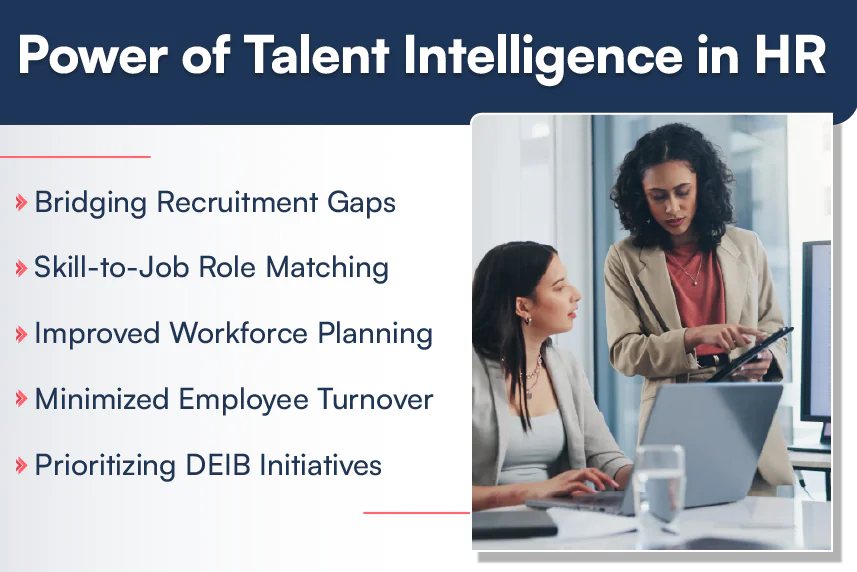
Identifying, developing, and retaining top talent can be challenging. Organizations may find it difficult to hire qualified individuals, provide tailored growth opportunities, and ensure employee engagement and satisfaction. AI-powered talent intelligence can addresses and resolve such issues by assessing candidates’ skills, prioritizing skill-to-job role matching, and creating seamless employee experiences.
Whether you want to build a scalable data-driven HR software product or go beyond conventional metrics to make strategic HR decisions, talent intelligence can be your go-to solution. It can break the barriers of hire-to-retire evaluation, offering a holistic view of an agile workforce driven by comprehensive skillsets, DEIB, and solid employee-HR relationships.
In this blog post, you’ll explore the key components of talent intelligence and how they positively impact HR. You’ll learn the most effective strategies to implement talent intelligence and address key pain points to best leverage this AI-based solution. Let’s begin.
What is Talent Intelligence?
Talent intelligence refers to the process of gathering, analyzing, and utilizing workforce data to make strategic decisions about hiring, retaining, and developing employees. It enables organizations to:
- Analyze extensive employee data
- Compare employee data with external labor market data
- Gather valuable insights to optimize workforce performance
- Make data-driven HR decisions to maximize business growth
Talent intelligence helps companies gain deeper understanding of employees’ skillsets, geographic preferences, technology expertise, certifications completed, career trajectories, and leadership capabilities. This AI-backed technology can automate skills gap analysis, improve talent development and retention, optimize pay equity strategy, and support succession planning.
“According to Aptitude Research, 72% of organizations are ramping up their investment in talent intelligence.”
Let’s understand talent intelligence with an example.
A company wants to increase sales. With the help of talent intelligence, the company can identify successful salespersons, analyze their abilities, and examine their earlier work history. This data can help them identify whether the hiring of the entire sales team is as per the abilities and work history of the successful salespersons.
Key Components of Talent Intelligence
There are three essential components of talent intelligence. Integrating these components allows organizations to make informed decisions that align with their long-term business goals and create a competitive advantage through effective talent management. Let’s understand each of these components in brief.
1. Employee Data
This component involves gathering and analyzing information about the current workforce. It includes data such as employees’ skills, experiences, performance metrics, career aspirations, and demographic information.
2. Talent Market
This component includes external data related to the labor market. It offers information about job trends, salary benchmarks, competitor analysis, and industry insights.
3. Strategic Analysis
This component involves using insights from employee data and the talent market to inform strategic decision-making. It encompasses identifying talent-related challenges and opportunities, setting goals and objectives for talent management initiatives, and developing actionable plans to achieve them.
5 Major Advantages of Talent Intelligence
What makes talent intelligence a pivotal tool is its ability to optimize your HR strategy. It offers various significant advantages for organizations looking to deliver effective HR and business results. Let’s understand these advantages in brief.
1. Create Personalized Hiring Criteria

Talent intelligence can close the hiring gaps with ease. It allows organizations to create personalized hiring criteria tailored to specific job roles, ensuring they attract and select candidates who possess the right skills and attributes.
With personalized hiring criteria, HR professionals can analyze various factors like work experience, personality traits, and performance metrics to develop a detailed profile of an ideal candidate. They can refine their hiring strategy to attract individuals:
- Who align with their company’s vision
- Who are more likely to excel in their roles
- Who perfectly meet the set workforce standard
2. Improve Skill-to-Job Role Matching
According to McKinsey, in many organizations, 20-30% of critical roles aren’t filled by the most appropriate professionals. This percentage can be significantly reduced through an effective skill-to-job role matching strategy powered by talent intelligence.
Talent intelligence can help organizations accurately assess the skills and competencies of their workforce and match them to the most suitable job roles. By using data-driven insights, companies can identify employees who possess the exact skills needed for specific tasks or projects, ensuring each role is filled by the most capable individual.
For instance, a technology company can use talent intelligence to match software developers with projects that require specialized coding skills. This can lead to more efficient project completion and better business outcomes.
3. Enhance Workforce Planning

Talent intelligence plays a crucial role in improving workforce planning by providing comprehensive insights into current and future talent needs. It can analyze employee demographics, skills, performance, and industry trends to forecast workforce demand and supply accurately. It can enable strategic decision-making by aligning talent management with business objectives.
Enhanced workforce planning via AI-based talent intelligence can help organizations identify critical roles and meet succession planning requirements. HR teams can ensure they have a pipeline of qualified candidates ready to step into key positions. They can minimize disruptions caused by unexpected departures and improve business productivity.
4. Reduce Employee Turnover Rates
High employee turnover not only impacts financial stability but also disrupts team dynamics and organizational continuity. According to SHRM, employee replacement costs can be as high as 50-60%, with overall costs ranging 90-200%.
Talent intelligence can significantly reduce turnover rates by identifying the factors that contribute to employee engagement, experience, satisfaction, and retention. It can evaluate employee data to uncover trends and patterns related to why employees leave or stay with their employer.
For example, talent intelligence can reveal which employees are more likely to stay with the company if they have access to career development opportunities and a supportive work environment. It can help businesses focus on essential aspects such as:
- At-risk employees
- Job satisfaction scores
- Engagement levels
- Absenteeism
5. Prioritize DEIB Initiatives
DEIB initiatives are critical for creating a fair and inclusive workplace. Talent intelligence helps organizations prioritize DEIB by providing data-driven insights into workforce demographics, hiring practices, and employee experiences. By analyzing this data, companies can identify disparities and biases in their talent management process and implement strategies to address them.
For instance, talent intelligence can help identify how the current workplace infrastructure causes difficulties for people with minor disabilities and whether this demographic is being heard.
How to Tackle Top Pain Points in Talent Intelligence
After understanding the benefits of talent intelligence, it’s time to learn how to address and resolve critical pain points to make the most of this AI-powered technology. This can help you accelerate your HR strategy and boost data-driven decision-making.
1. Pain Point: Inability to Mitigate Bias in AI Algorithms
AI algorithms used in talent intelligence platforms can perpetuate biases, leading to unfair or discriminatory outcomes in recruitment, performance evaluation, and other HR processes. Bias in AI algorithms can stem from various sources, including insufficient training data, lack of diversity in dataset representation, or inappropriate algorithm design.
Bias in AI algorithms can result in disparities in candidate selection, promotion decisions, and performance evaluations, adversely affecting DEIB efforts within organizations. It can reduce trust among employees and stakeholders, resulting in legal and reputational risks for organizations.
How to Resolve it
To eliminate bias, organizations need to prioritize diverse representation in the datasets used to train AI algorithms. They need to inhibit the likelihood of gathering, analyzing, and utilizing skewed or incomplete data.
While implementing AI algorithms in talent intelligence platforms, it is essential to employ bias detection algorithms, fairness metrics, and ethical framework for AI usage in HR. This will help monitor and refine AI models and improve fairness and accuracy of outcomes.
2. Pain Point: Difficulty in the Adoption of Talent Intelligence
Another critical pain point of HR professionals is the adoption of talent intelligence. The underlying cause of this issue is the complexity and unfamiliarity associated with integrating new technologies and processes. Organizations often struggle with understanding how to effectively implement and utilize talent intelligence tools, leading to resistance and slow adoption rates.
How to Resolve it

Collaborating with an experienced and competent implementation partner can resolve this issue with ease. They can guide organizations through the adoption of talent intelligence in manageable and incremental steps, ensuring each phase is understood and effectively executed.
This approach not only builds confidence within the organization but also fosters a smoother and more effective integration of talent intelligence solutions.
3. Pain Point: Lack of Support to Build Scalable Talent Intelligence-Enabled HR Products
Many product and technology companies struggle with inappropriate support and resources to develop scalable HR products powered by talent intelligence. This includes challenges in acquiring the right expertise and technological infrastructure necessary for effective development of the products.
On the other hand, organizations often find it difficult to combine the capabilities of advanced AI algorithms, talent intelligence, and HR system integration. They are unable to build a futuristic product roadmap.
How to Resolve it
The most effective way to overcome such challenges is investment in the right technology expertise. Product and technology companies need to collaborate with a trusted technology partner specializing in AI and HR Tech. This will help them unlock the true potential of talent intelligence, build innovative product roadmap, and develop scalable software products.
Want to accelerate product development and roadmap creation using AI? Get actionable insights from the second episode ‘How to Fast-Track the Product Roadmap Using Generative AI’ of our webinar series ‘The Tech CXO Roundtable’ organized in association with WorkTech Advisory.
4. Pain Point: Limited Expertise to Resolve Vulnerabilities and Security Issues
Ineffective implementation of a talent intelligence platform can introduce vulnerabilities and security risks. It can lead to data breaches, malicious activities, and unauthorized access to sensitive employee information. These vulnerabilities may arise from inadequate encryption protocols, weak access controls, or internal operational malfunction.
How to Resolve it
A plausible solution to tackle this scenario is the application of robust data encryption, secure access controls, and regular security audits. Organizations need to prioritize rigorous application testing methodologies like penetration testing, vulnerability scanning, and code reviews to ensure comprehensive security measures are in place.
Organizations can implement stringent patch management protocols to promptly address vulnerabilities in their talent intelligence platforms. Network segmentation need to be enhanced to limit the lateral movement of threats within the infrastructure.
Learn how Harbinger helped a leading talent cloud company address and remediate all vulnerabilities in their talent intelligence platform. Our solution successfully integrated SATS, DAST, and SCA tools to maximize application and infrastructure security.
Parting Thought
Talent intelligence is not just an innovative approach but a necessity for forward-thinking organizations. It helps HR professionals to think beyond traditional HR processes. It enables businesses to anticipate future workforce needs, identify the skills gap, and align talent strategies with business goals.
If you want to build transformative HR products powered by talent intelligence or seek dedicated assistance to implement talent intelligence within your organization, reach out to us. Our HR Tech experts would be more than happy to help you achieve your long-term HR and business goals.






